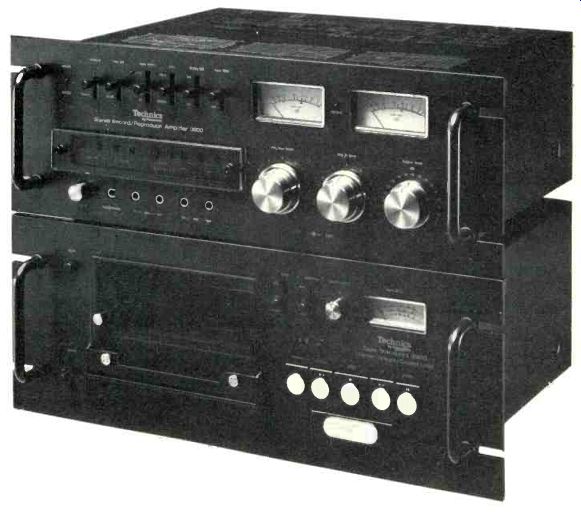
MANUFACTURER'S SPECIFICATIONS:
Frequency Response: 25 Hz to 18 kHz, and 25 Hz to 20 kHz with CrO2 tape.
Harmonic Distortion: 1.4 percent for 333 Hz at 160 nWb/m.
S/N Ratio: 57 dB wo/Dolby, 67 dB w/Dolby.
Input Sensitivity: Mike, 0.25 mV; Line, 60 mV, and AUX, 60 mV.
Output Level: Line and AUX, 0.42 V, and Headphones, 900 mV.
Wow & Flutter: 0.04 percent W rms.
FF & RWD Times: 70 sec. for C-60.
Dimensions: Transport, (19.4 cm) H x (48.3 cm) W x (37.5 cm) D; amplifier, (17.5 cm) H x. (48.3cm) D. x (37.5cm)D.
Weight: Transport, 33 lbs. (15 kg); amplifier, 19 3/4, lbs. (9 kg).
Price: $1500.00
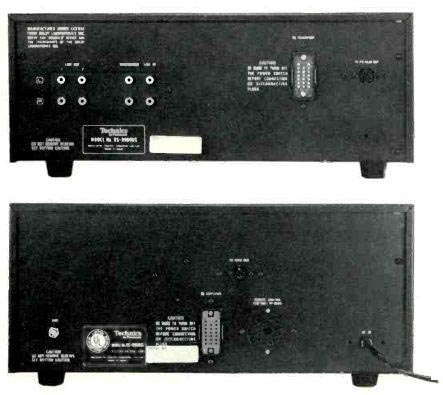
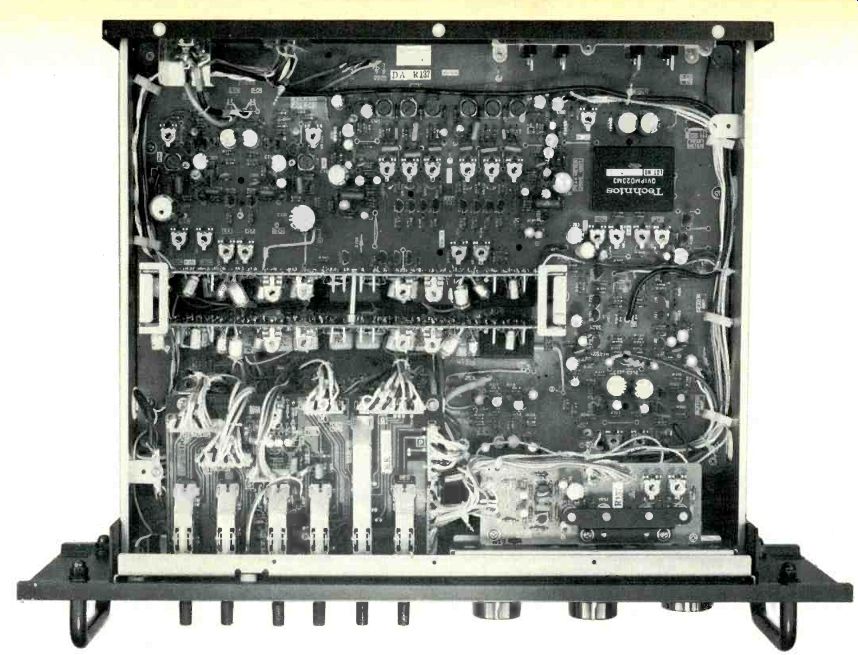

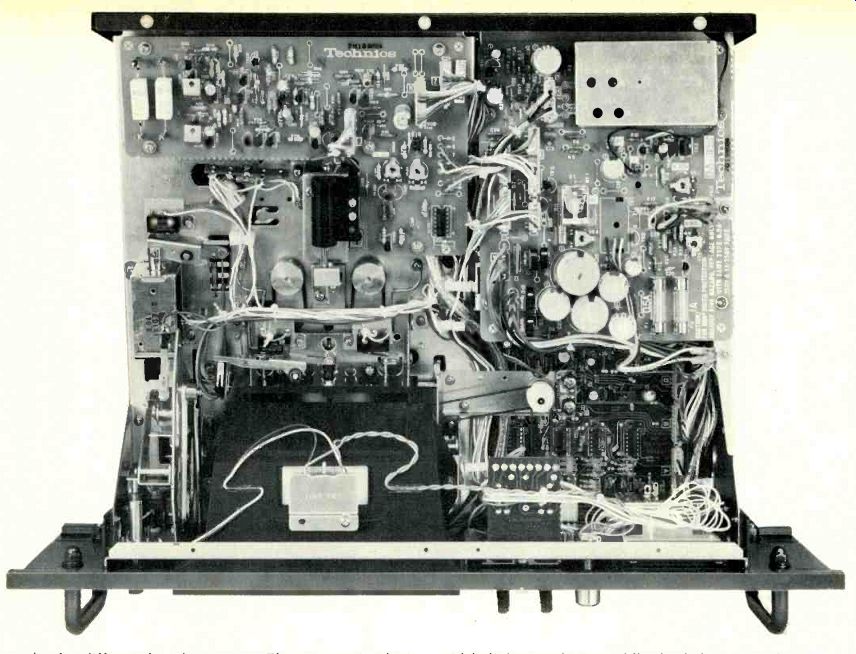
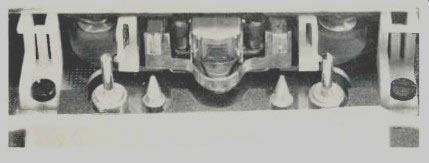
The multi-feature, two-unit Technics RS-990005 cassette deck includes such attractions as a closed-loop, double capstan, three-motor drive, and continuously variable bias and EQ, adjustable from the front panel. The amplifier and transport units can be operated on a table or bench side-by side, stacked with the amplifier on top, or rack mounted in the same configuration. The panel heights are not standard, but the slot spacing does match standard racks with a total height requirement of 14 inches. The lever switches on the top left of the amplifier are as follows: Tape/Source monitor, 0 dB/30 dB mike attenuator, FeCr/Normal/CrO2, tape select, 400-Hz/Otf/8-kHz test oscillator, Out/In/FM Dolby NR, and Out/In multiplex filter. The oscillator is particularly useful for level setting, adjusting bias and EQ, and aligning the record head to the playback head. There is a Cr02 status light showing whenever that bias and EQ has been selected, and there is automatic switching to CrO, for cassettes with the coding holes. The Power Sentry status light is illuminated several seconds after power turn-on, indicating that the system is ready for use. Just below, a removable clear plastic shield covers the record and play calibration pots, primarily for use with the Dolby NR. Each of the pots has a gentle detent at the center of its rotation, corresponding to the normal settings for tapes that match the preset bias and EQ, a nice, helpful touch. In the same recess is a push-button switch which selects either preset or variable bias and EQ. If Variable is selected, a status indicator goes on, and the single bias (both channels) and the two EQ pots are enabled. Bias can be adjusted over a range from-50 to +100 percent relative to that for normal low-noise tape. The EQ controls provide a response change of ±5 dB at 10 kHz with gentle detents at the center of rotation. The readily available and flexible bias and EQ adjustments must be considered one of the most helpful features of this deck ... unmatched by any other cassette unit. Headphone level has its own control, and it is not affected by the setting of the output level control. There are two AUX stereo phone jacks, in and out. This input can be mixed with the line input which has dual phono jacks on the back. Insertion of the mike phone plugs disconnect the AUX inputs. Two sets of dual, concentric pots control Mike/AUX level and Line-in level. The handy marker rings include detents when indexes line up, further increasing their usefulness. The output level attenuator-like control has 2-dB steps from +8 to-26 dB, plus settings of -29,-34,-42, and-oo. The well-illuminated meters are peak reading and cover a wide range from-40 to +5 dB, with the Dolby level reference mark at-5 dB.
There are dual line-out phono jacks on the back, which are also paralleled by the AUX-Out jack on the front. Also on the back are a remote control socket, a ground post, and 6and 20-pin sockets for interconnection with the transport unit. On the top are the calibration pots for the test oscillator and FM Dolby broadcasts. Printed on the top panel is a signal block diagram and graphs of bias characteristics, record EQ range, and the peak meter dynamic response.
The large, illuminated cassette well in the transport unit contains a large mirror which facilitates observation of tape motion. Eject opens the air-damped, clear plastic door and lifts the cassette up, but does not propel it out. There is a manual eject button inside for use when the power is off.
There is a removable head cover which provides access to the record-head azimuth adjustment and for maintenance tasks.
A timer switch provides the options of starting in Play or Record when power is turned on by an external timer. The memory switch can be set for Rew, Off, or Play. The Play position will result in the deck going into play as soon as it has rewound to "000." These two switches, and all those on the amplifier, are spring loaded, having excellent snap-like action from one position to the other. The pitch control functions on Play only and allows an adjustment of tape speed of ±5 percent. A tape time meter shows time remaining with separate scales for different length cassettes. The tape-motion logic control buttons are of the light-touch variety with status lights for each function, except Stop. Record acts as a preset in that once pushed, recording can be started by using just Play. The preset is defeated by using Stop.
The top-side and bottom covers were removed from both the amplifier and the transport. The tops of the circuit cards had very clear marking for parts, test points, and calibration and adjustment pots. The bottoms of the circuit cards evidenced excellent soldering and many helpful identifications. The construction used should aid in long-term reliability. Of particular interest was the direct-drive capstan motor with belt drive to the second fly-wheeled capstan. The capstan motor shaft rotates at just five revolutions per second and is of relatively large diameter.
Measured Performance
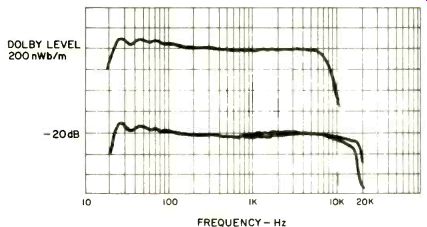
Fig. 1--The record and playback response with Maxell UDXL I tape with preset
bias and equalization, with and without Dolby.
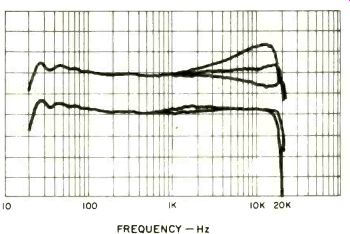
Fig. 2--Response of the Maxell UDXL I tape with variable bias and EQ at-20
dB (re: Dolby level of 200 nWbfm). The top traces are medium bias with low,
medium, and high EQ. The bottom trace is medium EQ with slight increase in
bias, with and without Dolby.
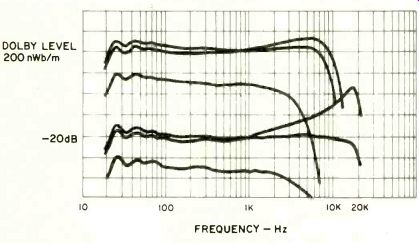
Fig. 3--Maxell UDXL I tape with variable bias settings. The EQ was at the
Mid setting while the bias was changed to the Minimum, Mid, and Maximum settings.
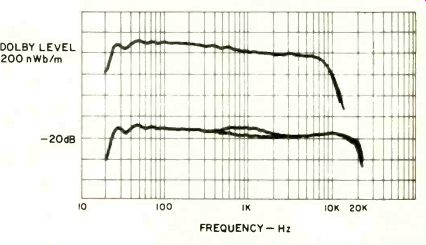
Fig. 4--Frequency response for the Scotch Master II CrO2 tape with preset
bias and EQ, with and without Dolby.

Fig. 5--BASF frequency response with both the preset and variable bias and
EQ adjustments. The top trace is with preset bias and EQ (Normal setting) showing
the record head adjustment to align with the playback head. The three lower
traces show the response with variable bias and EQ settings.
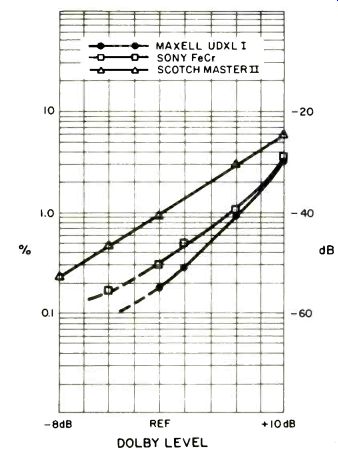
Fig. 6--Third harmonic distortion level (HDL3) vs. level at 333 Hz with the
Maxell UDXL I, the Sony FeCr, and the Scotch Master II cassettes.
The playback responses for 120and 70-microsecond equalizations were within 2 dB with the exception of -2.4 dB at 10 kHz for normal-tape EQ and slightly greater response above 4 kHz for the CrO2 EQ. Using the pink-noise and third octave RTA combination, a total of 40 tape formulations were tried with the deck. About half of these matched the preset bias and EQ, although several performed better using the variable settings. Good performance for 18 of the tapes required use of the variable bias and EQ. Only one of the 40 tapes, a bargain-priced tape, could not be made to have a good response. For each of these checks, the azimuth of the record head was adjusted, using the RTA display. The built-in oscillator was switched to 8 kHz, and the record head was aligned using the indications at-25 dB on the meters. The average error of alignment was 13 degrees at 8 kHz, which would be about 1.5 degrees at 1 kHz. This result is quite good, but it did require careful attention to small changes in meter indication. The record/playback phase jitter was 40 degrees at 8 kHz, very good for a cassette recorder. At 8 kHz (8201 Hz actual), the oscillator had almost 8 percent distortion, but this was not considered to be a limitation for its intended purpose.
The Dolby level calibration was very close, with the 200 nWb/m test tape giving an indication almost exactly on the Dolby reference mark at -5 dB. The play calibration pots were touched up to make all future levels reference to the test tape used. The level of the built-in oscillator was on the nose at 400 Hz (411 Hz actual), and distortion was about 2 percent. A number of Record/Playback responses were run using Maxell UDXL I tape. (Figs. 1, 2, & 3). The first set with Normal preset bias and EQ were quite flat at 20 dB below D.L. (Dolby level, 200 nWb/m). The responses extended from 21 Hz to 18.5 kHz, to 16 kHz with Dolby NR. At D.L., the -3-dB point was at 7.8 kHz, quite good for this level. Another set was run with UDXL I adjustments made in bias and EQ, gaining improvements in the high-end response. The Maxell tape was also used to show the range of effects from adjusting bias. As expected, the changes were dramatic, going from a +12-dB peak at 17 kHz for minimum bias to a 7-dB or greater loss at all frequencies with maximum bias. At D.L., Scotch Master II (CrO, EQ) with preset bias and EQ (Fig. 4) showed headroom out to 8.7 kHz, better than with the Maxell tape. At 20 dB lower, the response was from 22 Hz to 20.5 kHz, to 18 kHz with Dolby. The response with Dolby also showed a small rise in level in the mid-frequencies, as also evidenced with the UDXL I. BASF Performance (Fig. 5) was one of the tapes that had not performed that well with preset bias and EQ. Plots were made with that condition and with the record head purposely not aligned to show the need and possibility of corrections. Head alignment gained about 6 dB at 10 kHz, and bias and EQ gained another 5 dB or so and extended the response significantly. During the course of these and other tests, it was noticed that the level of residual bias in the output (when in record, of course) was very, very low. That shows excellent design and adjustment of the bias traps.
The relative distortion level of the third harmonic, HDL,, was measured at 333 Hz (Fig. 6) over a range of record levels from 8 dB below to 10 dB above D.L., 200 nWb/m on playback (Fig. 7). Technics specifies 1.4 percent distortion at 160 nWb/m for 333 Hz, puzzling for the choice of reference level and the fact that the actual distortion is 0.65 percent or less at that level, much better than their spec. Maxell UDXL I was the best performer of the three tapes tried, with HDL, down almost to 0.1 percent at the reference level. Below D.L., HDL, was mixed in among noise and miscellaneous harmonics generated in the electronics. This is certainly excellent low-distortion performance, but some reduction in the low-level distortion in the electronics would make this excellent machine even better. Distortion level was almost as low with Sony FeCr as with the Maxell, but notably higher with Scotch Master II. Checks with other CrO2-type tapes showed the Scotch tape to be one of the best. The results in this case appear to be further evidence that CRO2 type tapes will usually have higher distortion. The conclusion of this reviewer is that the relatively lower distortion figures for such tapes reported elsewhere is the result of using regular harmonic distortion meters, rather than spectrum analyzers.
Because of the lower noise which is gained with the 70 microsecond EQ, the meter would give a lower "distortion" rating to the CrO2 type tape. Using the same three tapes, measurements were made of HDL, vs. frequency at D.L. Distortion figures were too low at 10 dB below D.L. to obtain anything but partial data at the frequency extremes. Particularly noteworthy are the low distortion levels at the lowest frequencies.
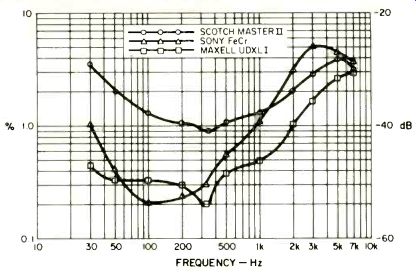
Fig. 7--HDL3 vs. frequency at Dolby level (200 nWb/m) with the Maxell UDXL
I, the Sony FeCr, and the Scotch Master II tapes.
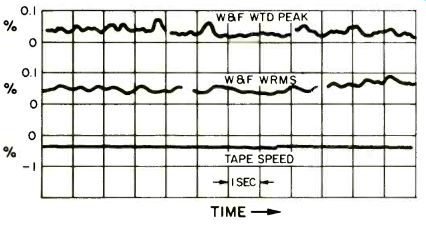
Fig. 8--The wow and flutter and tape speeds at the beginning, middle, and end
of a C-90 cassette.
Signal-to-noise ratios are referred to the "maximum recording level" in the 9900 specs, and the assumption was made that Technics was using HDL, = 3 percent as that point.
Referred to D.L., the ratios for three tapes were about 46 to 52 dBA and about 55 to 59 dBA with Dolby. For HDL, = 3 percent which was several dB above D.L., the ratios were 55.7 to 59.9 dBA and 64.6 to 67.4 dBA with Dolby. Sony FeCr had the best ratios, and Scotch Master II was slightly better than Max ell UDXL I. Separation from B to A was 40 dB, and crosstalk from B to B of opposite play direction was 80 dB down. Erase of a 1000-Hz tone at D.L. was to at least 78 dB down, excellent performance. After a little diddling, the conclusion was reached that Technics' reference for sensitivities was-8 dB on the meter. This level is shown with a red line on the meter faces, and the instruction book states that this is the overload point for VU meters. This indication, equivalent to about 140 nWb/m, is close to where some cassette recorder meters show zero, but the rationale for classifying this as an overload point is not clear. For this-8-dB indication, mike sensitivity was exactly as specified, 0.25 mV. Line and AUX sensitivities were 71 mV, a bit higher than the specified 60 mV. For the same-8-dB indication whether in source or tape monitor, the Line/AUX outputs were 0.43 V (0.42 V. spec) with the output level pot at zero reference. With a D.L. indication, the output was 0.6 V. Setting the pot to +8 increased the level to 1.5 V. The Mike/AUX and Line-in pots tracked within a dB from +5 down to-40 dB, with even less error above -15 dB. The mike amplifier was linear over a 59-dB range with a +5 maximum-level reference. With the attenuator, an accurate 30 dB, the range was increased to about 75 dB. Line and AUX input impedances were about 100 kilohms, and their common output Z was about 3.3 kilohms. The output level control had accurate steps of attenuation of the output signal, and the two sections had excellent tracking. There is no effect on the meter indication with changes in the setting of this pot. The drive to 8-ohm phones was the specified 0.9 V with 0 dB on the meter and the headphones level pot at maximum. Meter scale markings were very accurate over the entire range from -40 to +5 dB, and both meters tracked very closely. The frequency response was down 3 dB at 23 Hz and 22,940 Hz per meter indication. The dynamic response to test tone bursts was very fast, indicating about -1.5 dB with a 10-mS isolated burst and about -5 dB with a 1.5-mS burst. These responses are faster than those shown in the Technics figure and those in the British program meter standard. Decay time was much slower, of course, and appeared to be satisfactory.
The Record/Playback wow and flutter (Fig. 8) varied from a little less than 0.02 percent to an infrequent 0.07 percent W rms. The average value was about 0.035 percent, just under the specified 0.04 percent, W rms. On a weighted-peak basis, the figures varied from 0.03 to 0.085 percent, with an average of about 0.06 percent, just plain outstanding performance.
One indication of the superior drive characteristics of the 9900 was that low wow and flutter readings were obtained from a number of cassettes that had been mediocre performers in this regard in other machines. Tape speed with the deck in the Record mode was about 1 percent fast, and Playback of the standard tape showed its in-detent speed to be about 0.7 percent fast. The Record/Playback speed change resulting was about 0.3 percent slow, as shown in the tape speed plot. Speed was consistent throughout the cassette, and there was about 0.1 percent speed change for a 10-volt change in line power. The playback speed control had a range from-4.8 percent to +6.8 percent relative to its detent position (a semitone is a 5.9 percent change). When examining the internal construction earlier, the speed adjust pot had been noted, and the record speed was easily reset to that desired. The average wind time for a C-60 cassette was 63 seconds. The tension-controlled wind was very smooth and quiet, particularly with some of the cassettes.
Listening and Use Tests
Cassette insertion was very easy, but some care was needed early on to ensure that it was seated all the way as there were a couple cases of getting half-way into Play without the cassette being fully into position. Maintenance tasks were more easily performed than on most front-loading machines, but head cleaning did require a little fussing. The switches and controls continued to make favorable impressions throughout the testing. The snap-like positioning of the lever switches and the smoothness of the pots provided mounting evidence of the deck's quality construction. The marker rings could be easily set or rotated as desired, and the pots could be easily turned into or out of detent without shifting the marker ring. Bringing an input pot up to level could be done quickly without needing to look at the ring, quite helpful when you have to watch something else. The output level could be changed the desired amount and easily returned exactly to the original setting. The logic-controlled, tape-motion switching performed flawlessly, regardless of all attempts to cause some sort of failure. Changing wind direction was immediate, and the delay from wind to Play was very short. There was automatic take-up of any loose loops in the cassette, as inserted. The operation of the timer, memory, pitch control, and tape timer was without any sort of failure in a number of various tests and for several different recording purposes.
The record calibration pots were used occasionally when a change in tape formulation required the adjustment for the difference in record sensitivity. There were many occasions to switch back and forth between preset and variable bias and EQ, adjusting the pots to match the new tape. For performing tasks such as these, the Technics RS-990005 is superb and not matched by any other cassette system. The inclusion of detents with many of the pots is not only a definite sophistication, but also a practical aid in usage. The instruction book is not lengthy, but it is very well written and illustrated.
There are helpful pertinent notes included throughout the text to answer questions that might arise. It is written more for the serious audiophile than for the professional, but the information included would be needed by most owners. A schematic is provided which is detailed for the amplifier, but shows just major blocks for the transport.
For many of the tapes used with the machine, the playback sounded just like the original. With some where the lowest frequencies were slightly higher in level, as shown in the 1/3 octave checks, there was a subtle shift to the bass region. The balance of some tapes sounded slightly better with Dolby NR, perhaps because of the midrange boost observed in the plots.
The peak-reading meters were a joy to use, and the decay time appeared right. There were no record clicks detected, but stop clicks could be heard and caused an indication of about -40 dB on the meters. Using the built-in 8-kHz tone alignment of the record head could be done quite rapidly, but earlier tests had shown that greater care produced better alignment. When the cost of the Technics RS-990005 cassette deck is considered, the acquisition might very well be thought of as an investment. With the performance and features of this unit, to say nothing of the 10-year warranty on the record and playback heads, there are many possible returns for its owner.
-Howard A. Roberson
-----------------
WILL THE REAL REFERENCE LEVEL PLEASE STAND UP?
Evaluating tape recorders continually emphasizes the problem of selecting, using, and reporting reference levels. It might seem that "0 VU" says it all, but not so. I suspect that most of Audio's readers know that "VU" on a meter face is no guarantee that it meets ANSI Standard C16.5-1954. The standard is quite specific on the required frequency response and the dynamic response to a 0.3 second tone burst. The true VU meter also has an exact level reference, 0 VU for 1 mW in "R" ohms. Because of the relatively low resistance of the meter, isolating resistors are usually needed to keep from loading down the line which is being monitored. For a 600ohm line, the result is that the meter indication of 0 VU will occur with +4 VU in the line. Take particular note here that the indication on the meter is tied to a line level, and that is what the meter was originally designed to measure.
The NAB 1965 standard for reel-to-reel tape recorders indicates an equivalency between a properly calibrated VU meter and distortion in the recorded signal. The recommended practice is to adjust the meter for a 0 VU indication 8 dB below the level where HDL3 (the level of the third harmonic) is 3 percent at 400 Hz. The NAB 1973 standard for cassettes is expressed differently, giving the reference in tape flux level: 200 nWb/m (nanoWebers per meter) at 400 Hz. The standard states that "this is about 3 to 4 dB below the level for a third harmonic distortion level of 3 percent." Note that the standards themselves accept higher distortion levels in the cassette format for the same meter indication. The standards cannot be accepted in toto as gospel because tape technology has improved greatly, changing the relationships presented in the documents.
Perhaps the 200-nWb/m figure is familiar to you as the flux level for the Dolby reference level for cassette tapes. In the future, Audio will give preference to this reference level for both open-reel and cassette recorders. The choice is made for simple, practical reasons. Cassette recorders have absolutely no consistency in calibration of meters, and the significance of a "0 VU" level was usually lost in the modifying comments that had to be attached with half the tests. The alignment tapes used have a reference level of 250 nWb/m, almost 2 dB higher than 200 nWb/m. Once again, explanations were needed to explain where this level would actually appear on a particular meter. The Dolby level reference mark on a cassette recorder's meter consistently shows when the flux level of the tape being played is 200 nWb/m, or how much more or less.
Because the Record/Playback performance of the tape recorder is ultimately determined by flux levels, the evaluation of its performance should be tied to this essential property. Swept Record/Play responses must be run at the same, known flux levels for accurate assessment of the results and to facilitate comparing one machine to another. Running the same test, but relying on each meter zero as the reference, could result in differences in flux level of several dB. The results might be considerably different, but have little to do with the differences in real performance. These same criteria apply to any tests of distortion, whether as a function of frequency or with changes in record level. The measurement of relative distortion has to be made on the playback signal of course, and the reference level used in the future will be 200 nWb/m at 1000 Hz.
The check of signal-to-noise ratio benefits from using the same 200 nWb/m reference level for one figure, but it is most common to report this ratio relative to HDL3=3 percent. If we measure the output signal, increasing the record level until HDL3=3 percent, and continue recording without a signal, the true S/N ratio can be measured. The approach used by many is to make S/N measurements at a lower level, perhaps meter zero. Then, the record level is increased until the 3 percent point is reached, and the dB increase in record level is added to the S/N figure obtained earlier. The failure with this method is that there is always some compression at the level causing 3 percent HDL3. The real S/N ratio resulting, as measured directly on the playback signal, is perhaps one or two dB less than reported, or perhaps specified.
Another practice, or error, is to measure the 3 percent HDL3 point at some frequency other than 1 kHz, such as 400 Hz, which has a lower distortion. Thus, a higher level is measured on the output without any of the weighting normally used for noise measurements. Then, with the signal removed, the record noise is measured with the weighting.
This will get higher numbers, but our practice will continue to be using 1 kHz, which is the reference frequency for both ANSI/I EC "A" weighting and CCIR Rec. 468.
Readers may have noticed that some manufacturers specify S/N ratios for Dolby NR as "above 5 kHz." That's another way to get better numbers, but the entire spectrum will be measured with "A" weighting and also with CCIR in the future, which does put more emphasis than "A" weighting on the highest frequencies.
=================
(Source: Audio magazine, Jun. 1978)
Also see:
Technics Model RS-616 Cassette Deck (Equip. Profile, Feb. 1979)
Sanyo Model RD5350 Stereo Cassette Deck (Feb. 1979)
Technics Model RS-1500US Stereo Open-Reel Tape Recorder (May 1977)
= = = =